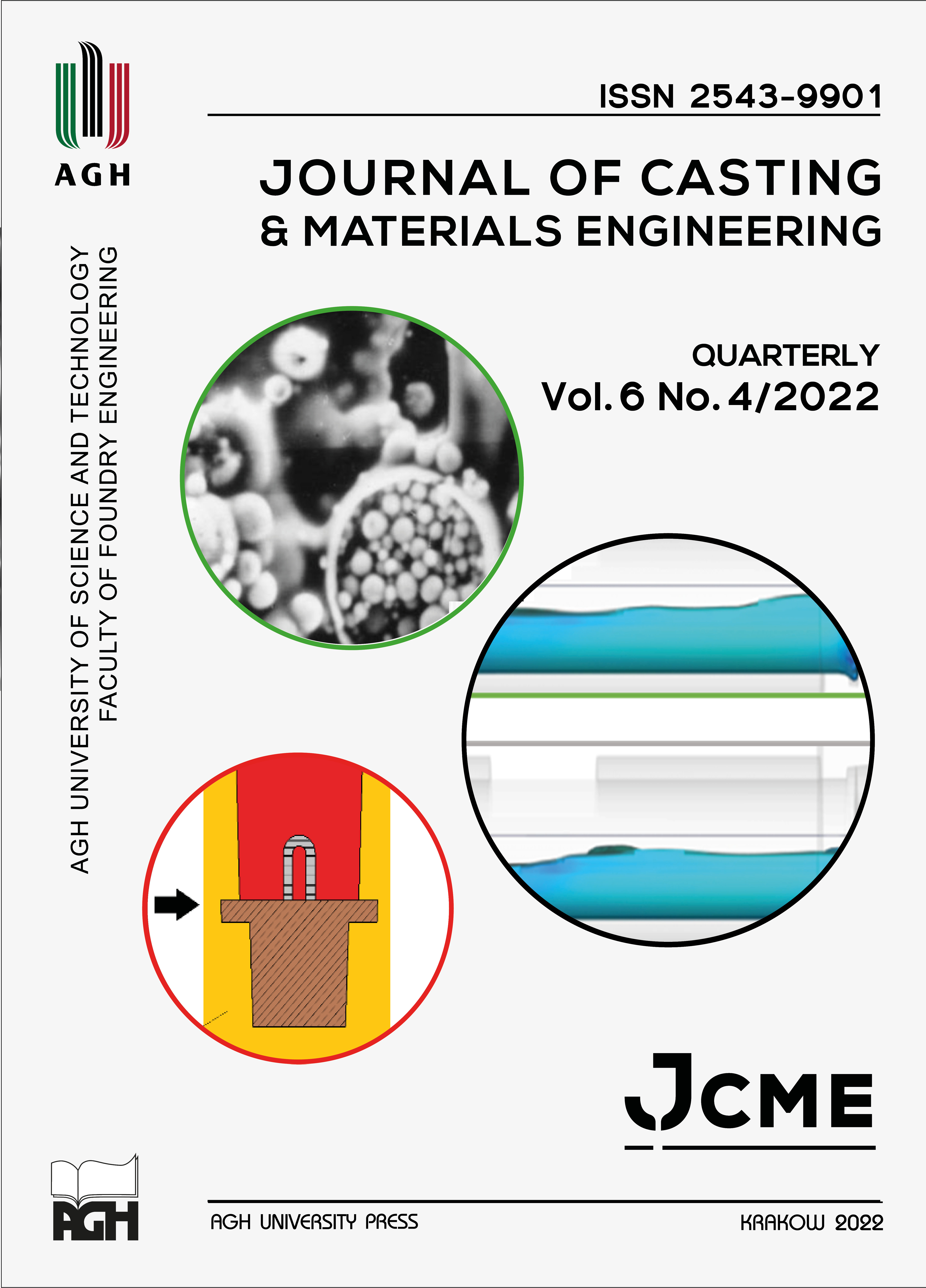Optimization of Ladle Tilting Speed for Preventing Temperature Drops in the Die Casting Process
DOI:
https://doi.org/10.7494/jcme.2022.6.4.69Abstract
In die casting, molten metal poured into a shot sleeve is pressed into a mold by a plunger at high speed. The temperature of the metal drops significantly while it is being poured from the ladle to the shot sleeve, resulting in casting defects such as misrun flow lines. Although it is important to control the temperature at all stages of the process, a method for minimizing temperature loss has not yet been clarified to date. In this study, the cause of the temperature drop in the shot sleeve was clarified, and a method of optimizing the ladle tilting speed was proposed to prevent temperature drop. First, experiments were conducted to measure the decrease in metal temperature in the sleeve during pouring. These experiments revealed that the metal cools significantly from the moment it touches the shot sleeve. Therefore, the time from the first contact between the shot sleeve and the metal to the start of pouring was set as the objective function. A genetic algorithm was then used to derive the optimal ladle tilting speed pattern to suppress the temperature drop. This analysis confirmed that the metal was poured without flowing out or running ahead and that the immediate liquid level vibration after pouring was suppressed, thus ensuring stable pouring.
Downloads
References
Laukli H.I., Arnberg L. & Lohne O. (2005). Effects of grain refiner additions on the grain structures in HPDC A356 castings. International Journal of Cast Metals Research, 18(2), 65–72. Doi: https://doi.org/10.1179/136404605225022919.
Yu W., Cao Y., Guo Z. & Xiong S. (2016). Development and application of inverse heat transfer model between liquid metal and shot sleeve in high pressure die casting process under non-shooting condition. China Foundry, 13, 269–275. Doi: https://doi.org/10.1007/s41230-016-5137-4.
Sugihara T., Fujishiro M. & Maeda Y. (2019). Direct Observation and simulation of ladle pouring behaviour in die casting sleeve. VI International Conference on Particle-Based Methods: fundamentals and applications, 28–30 October, Barcelona. Barcelona: CINME, 610–618.
Vachhani H., Rathod M. & Shah R. (2019). Dissolution and erosion behavior of AISI H13 shot sleeve in high pressure die casting process. Engineering Failure Analysis, 101, 206–214. Doi: https://doi.org/10.1016/j.engfailanal.2019.02.021.
Abid D., Ktari A., Mellouli D., Gafsi N. & Haddar N. (2019). Failure analysis of shot–sleeves used in brass high pressure die–casting process. Engineering Failure Analysis, 104, 177–188. Doi: https://doi.org/10.1016/j.engfailanal.2019.05.038.
Korti A.I.N. & Abboudi S. (2017). Effects of shot sleeve filling on evolution of the free surface and solidification in the high-pressure die casting machine. International Journal of Metalcasting, 11(2), 223–239. Doi: https://doi.org/10.1007/s40962-016-0051-5.
Iwata Y., Dong S., Sugiyama Y. & Iwahori H. (2013). Effects of solidification behavior during filling on surface defects of aluminum alloy die casting. Materials Transactions, 54(10), 1944–1950.
Doi: https://doi.org/10.2320/matertrans.F-M2013819.
Helenius R., Lohne O., Arnberg L. & Laukli H.I. (2005). The heat transfer during filling of a high-pressure die-casting shot sleeve. Materials Science and Engineering: A, 413–414, 52–55. Doi: https://doi.org/10.1016/j.msea.2005.08.166.
Yu W., Cao Y., Li X., Guo Z. & Xiong S. (2017). Determination of interfacial heat transfer behavior at the metal/shot sleeve of high pressure die casting process of AZ91D Alloy. Journal of Materials Science & Technology, 33(1), 52–58. Doi: https://doi.org/10.1016/j.jmst.2016.02.003.
Kanazawa K. (2015). Nonparametric shape optimization methods using parametric curves. Graduate School. Mie University [Doctoral Dissertation].
Downloads
Published
Issue
Section
License
Copyright (c) 2022 Haru Ando, Daichi Minamide, Yuto Takagi, Ken’ichi Yano, Naoto Nakamura, Masahiro Sano, Takahiro Aoki, Yasunori Nemoto

This work is licensed under a Creative Commons Attribution 4.0 International License.
How to Cite
Accepted 2022-07-13
Published 2022-12-22


